1832-1950s - New Basin Canal

1948
This photograph of the New Basin Canal at West End was probably taken after the 1948 hurricane in connection with a beach erosion control study conducted by the Corps of Engineers. The Southern Yacht Club is at the right of the canal entrance and, behind it, the Municipal Yacht Harbor and West End Park. On the left is the lighthouse station. The group of buildings behind and to the left of the lighthouse is Lakeshore Hospital, formerly known as Lagarde Army Hospital. The western half of the Lakeshore subdivision currently occupies the site.
The New Basin Canal no longer exists. It was filled in during the 1950's to create the Potchartrain Expressway & West End Boulevard.
Source: New Orleans Public Library--Images of the Month
http://nutrias.org/~nopl/monthly/sept98/sept98.htm
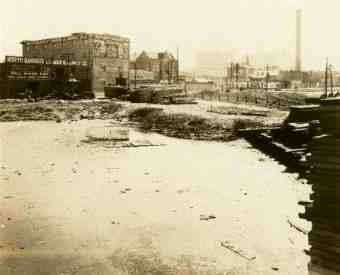
1700s
The 'Old' Basin Canal built in the late 18th century by Governor Carondelet to link the city to the Lake. Originally called the Carondelet Canal. Mules pulled barges filled with people to the Lake.
Source: New Orleans Public Library--Crescent City Memory Collection
http://www.gnofn.org/~nopl/exhibits/ccmem/8.htm
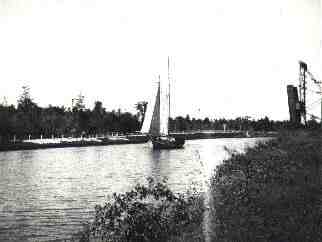
1830s
The New Basin Canal, which terminated near the present-day site of the Union Passenger Terminal and followed the route now taken by the Pontchartrain Expressway, served as the city's link to the Lake from the 1830s until the 1950s.
Source: New Orleans Public Library--Crescent City Memory Collection
http://www.gnofn.org/~nopl/exhibits/ccmem/2.htm
------
It was built between 1831 and 1838, by Irish immigrant labor, claiming the lives of many men who work on its construction. The canal served as a transport route between downtown New Orleans and Lake Pontchartrain.
Pleasure seekers could take a mule-drawn barge, complete with musical entertainment, along the New Basin Canal to the resort at New Lake End (now known as West End). This quote is from the Save Our Lakes website.
The New Basin Canal, was built by Irish immigrants. The arduous task of digging the canal through alligator and
snake-infested swamps began in 1832. In that same year, a cholera epidemic
hit the city and 6,000 people died in 20 days, many of whom were Irish.
When the canal opened for traffic in 1838, there were 8,000 Irish laborers
who would never see their homes again, having succumbed to cholera and
yellow fever. It was the worst single disaster to befall the Irish in their
entire history in New Orleans.
Ironically, the New Orleans canal and banking company which owned and built
the canal was founded by the aforementioned Maunsel White, and another
Irish-born gentleman, Charles Byrne, was a major shareholder. Financially,
the canal was a success as it opened up trade with communities north of
Lake Pontchartrain and the cities of Biloxi, Mobile, and Pensacola on the
Gulf of Mexico. As the city spread north, finally reaching the lake, its
usefulness began to decline. A fund was established to erect a
monument to the thousands of Irish who lost their lives building it.
Source:http://www.google.com/search?q=cache:AcgX7Jc0_DI:migration.ucc.ie/euromodule/documents/Irish%2520in%2520New%2520Orleans.txt+%22pontchartrain+railroad%22&hl=en

ca. 1880
Title: Bayou view West End
Creator: Mugnier, George Fran?ois, 1855-1936
Description: Moored sailboats on the bayou. Rowles Stereograph Photographs
Source: Louisiana State Museum
http://appl005.lsu.edu/LSM.nsf/0d6463f4d93cecd68625689c00470f5c/d09b457e64d6880a862569f9004f7774?OpenDocument
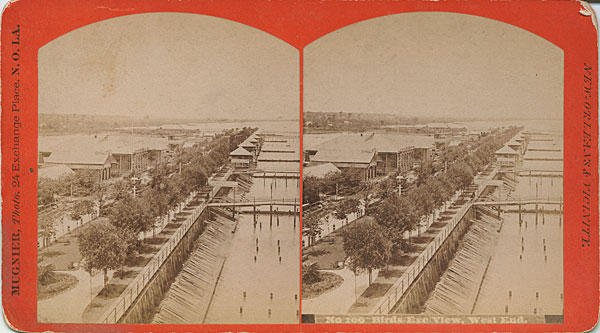
ca. 1880
Title: Bird's-eye view West End
Creator: Mugnier, George Fran?ois, 1855-1936
Description: The bulkhead of a coastal waterway. Rowles Stereograph Photographs
Source: Louisiana State Museum
http://appl005.lsu.edu/LSM.nsf/0d6463f4d93cecd68625689c00470f5c/a2086b4732a4ef69862569f9004f7769?OpenDocument
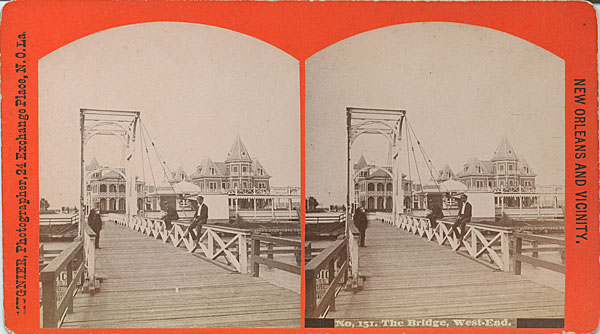
ca. 1880
Title: Bridge West End
Description: Men sitting on the railing of a wooden bridge. West End pavilion and hotel in
background. Rowles Stereograph Photographs
Source: Louisiana State Museum
http://appl005.lsu.edu/LSM.nsf/0d6463f4d93cecd68625689c00470f5c/f8c6853c67572b65862569f9004f77b8?OpenDocument
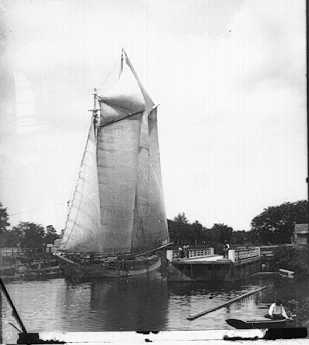
Lumber Schooner, New Basin Canal
George Fran?ois Mugnier
New Orleans, c. 1895
Most Irish immigrants who arrived at the port of New Orleans stayed in the city, primarily because they could not afford passage farther inland. Crowding into the city's riverfront neighborhoods, they strained its limited housing, employment, and education. Forced to compete with slaves and free blacks at the bottom of the economy, many New Orleans Irish took low-paying, often dangerous manual jobs, such as digging canals and ditches, building roads, levees, and railroads, and laboring on the docks and in the warehouses. The mortality rate was especially high among canal diggers, who were highly susceptible to yellow fever, malaria, and cholera.
Source: http://lsm.crt.state.la.us/cabildo/cab8.htm

New Basin Canal, ca. 1900. This view, taken from the Lake Pontchartrain entrance to the canal, shows several of the structures that comprised the West End resort. The lighthouse is still standing, but the larger buildings behind and to its right have long since disappeared.
Source: http://nutrias.org/monthly/oct98/oct9810.htm

1906
A postcard illustrating the shell road and canal (New Basin Canal) described in Mark Twain's 'Life on the Mississipi' (1874).
Reads 'Shell Road Toll Gate, New Orleans, La.'
Publisher: 'Phostint' By Detroit Publishing Company, #10285 At top, In Pencil -Notes: Toll House At Left - Unpaved Road - Canal At Right, With Small Steamer And Other Boats, Barges -
Copyright 1906 By The Detroit Publishing Company -Blue Title.
Source:thepostcard.com
http://www.thepostcard.com/
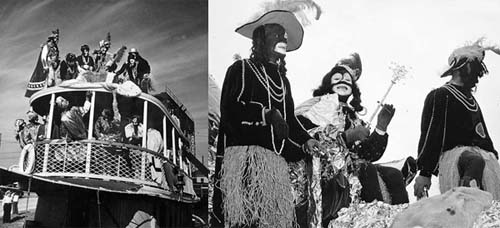
Louis Armstrong as King Zulu arriving by tug at New Basin Canal, 1948
Photo Source: http://www.museevirtuel.ca/Exhibitions/Festiva1/en/zoom/lsm10.html
The History of Zulu
There are many versions of the actual age of the Zulu Social Aid and Pleasure Club. However, many of the
articles written by journalists and columnists have been disproven by authentic documents of the Zulu Club and
information gleaned from old-time members and friends. These are the facts:
Early in 1909, a group of laborers who had organized a club named 'The Tramps', went to the Pythian Temple
Theater to see a musical comedy by the Smart Set. The comedy entitled 'There Never Was and Never Will Be
A King Like Me', a skit about a Zulu tribe. As soon as members of 'The Tramps' saw the skit, they put their
heads together in a woodshed on Perdido Street and emerged as 'Zulus'. the site of the original Zulu Clubhouse
in the 1100-block of Perdido Street is still marked by its inscription 'Zulu S.A.P. Club' in blue and white tile in
the sidewalk at a bus-stop.
They made their first appearance as Zulus in the Mardi Gras of 1909 with William Story as King. Members, clad
in ragged trousers, paraded on foot to the music of a Jubilee Singing Quartet. King Story wore a lard-can
crown and carried a banana stack scepter. The Zulus paraded exclusively in the Negro Section of the City.
In 1914, King Henry Harris, riding in a buggy, led the Zulus for the first time in the Rex Parade following the
White Easy Riders Club. He smoked Cairo cigarettes and saved the flags that came in the packages for an
entire year so that he could lead the Zulus in his 'hand-made' smoked flag suit.
In 1916, with dry good boxes, the Zulus made a float on a spring-wagon and carried four Zulu dukes on it with
King John White surrounded by a jungle of Palmetto leaves and green moss.
On September 20, 1916, the Zulus incorporated and became what is now known as the Zulu Social Aid and
Pleasure Club, Incorporated.
In 1917, Zulu King James Robertson, not to be outdone by Rex arriving on a yacht at the foot of Canal Street,
had himself rowed through the New Basin Canal in a skiff. In further burlesque of Rex, he carried a huge
hambone for a scepter. World War I began that same year and the Club disbanded until 1920.
When the Club resumed activities in 1920, King Freddy Brown not only had a float built by members, but he also
had an entourage of six dukes. They arrived in the New Orleans Basin Canal in a skiff with a motor. In 1921,
King James Robertson had the first Zulu float constructed by a professional float builder.
In 1922, King Hebert Permillion rented a yacht for $25 and he and his ukes shared the cost for the King's
float...the Zulu Club provided the second float and hired a band. The 'carnival parade money' was raised by
having a dance.
In 1923, when Joseph Kahol was King, a new idea was added which was to last tenyears. A male member of
the Club impersonated a Zulu Queen. Then in 1933, when Allen Leon reigned as King, his Royal Consort was the
Club's first bonafide Queen, Mrs. Mamie Williams.
King Zulu and his entourage still arrive via boat, but leave from Poydras Street and the Mississippi River for the
boat ride to the foot of Canal Street. Symbolically, King Zulu has made the voyage from his mythical Kingdom,
Zululand, to New Orleans. The King and his Krewe, the Soulful Warriors, are then taken via motorcade to
Washington and Freret to board the floats and set out on their grand parade route through the streets of New
Orleans.
In 1967, Zulu returned to the old tradition of grass skirts and blackface. Zulu still preserves the custom. The
favors/throws handed out by the Zulus on Mardi Gras Day include the official Zulu dubloon, the Black Bead,
thrown for the first time in 1977, and the famous Zulu Coconut, referred to as the 'Golden Nugget'. The
coconuts are decored by each individual member. The basic colors of the coconut are gold, silver and black. In
addition, each coconut is decorated with various colors of glitter. Each coconut will have either the letter 'Z'
or the word 'ZULU' printed on it.
Over the years, many prominent citizens portrayed the role of King Zulu. However, the most popular and the
most colorful and renown was the world famous trumpet player, Louis 'Satchmo' Armstrong, King Zulu 1949.
With the growth in popularity of the Zulu Club, it is now one of the main attractions of the New Orleans Mardi
Gras. King Zulu's parade, relegated to back streets of the Black community, rolled onto Canal Street in 1969
and is now the first Krewe out on Mardi Gras Day!
As the King Zulu King Cake is cut, the person who gets the 'baby' is obligated to bring a Zulu King Cake to the
next seasonal celebration. King Cake season ends on Fat Tuesday, the day before the beginning of Lent.
Source:
The Ambrosia Bakery
http://www.ambrosiabakery.com/kingcakes.asp
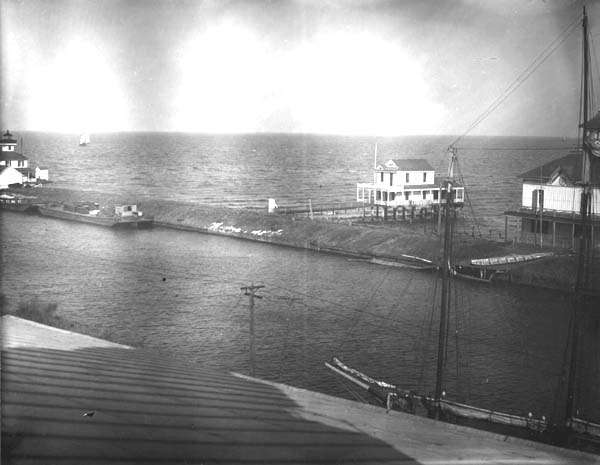
date unknown
Builders of the New Basin Canal, which connected the downtown American sector of New Orleans with Lake Pontchartrain, preferred to hire Irishmen because the work was dangerous, and they did not want their valuable slaves injured or killed. Laboring in water up to their hips, canal diggers were very susceptible to yellow fever, malaria, and cholera. Estimates of the number of Irishmen buried along the New Basin Canal ranged from 3,000 to 30,000.
Source: http://lsm.crt.state.la.us/museum/education/irish3.htm
Nathanial H. Benjamin quote (1879):
The first part of this canal runs through the city proper, and then through a low swampy region out into the shallow lake Pontchartrain. At the terminus of New Basin Canal I found a small light-house, two or three hotels, and a few houses, making a little village.
A small fleet of schooners, which had brought lumber and firewood from Shieldsboro and other Gulf ports, was lying idly along the sides of the canal, awaiting a fair wind to assist them in making the return trip.
I rowed out of the canal on to the lake; but finding that the strong wind and rough waves were too much for my boat, I beat a hasty retreat into the port of refuge, and, securing my bow-line to a pile, and my stern-line to the bob-stay of a wood-schooner, the 'Felicité,' I prepared to ride out the gale under her bow. The skippers of the little fleet were very civil men. Some of them were of French and some of Spanish origin, while one or two were Germans. My charts interested them greatly; for though they had navigated their vessels for years upon the Gulf of Mexico, they had never seen a chart; and their astonishment was unbounded when I described to them the bottom of the sea for five hundred miles to the eastward, over a route I had never travelled.
Night settled down upon us, and, as the wind lulled, the evening became lovely. Soon the quiet hamlet changed to a scene of merriment, as the gay people of the city drove out in their carriages to have a 'lark,' as the sailors expressed it; and which seemed to begin at the hotels with card-playing, dancing, drinking, and swearing, and to end in a general carousal. Men and women joined alike in the disreputable scene, though I was informed that this was a respectable circle of society, compared with some which at times enlivened the neighborhood of Lake Pontchartrain. Thinking of the wonderful grades of society, I tried to sleep in my boat, not imagining that my peace was soon to be invaded by the lowest layer of that social strata.
In spite of all my precautions an article had appeared that day in a New Orleans paper giving a somewhat incorrect account of my voyage from Pittsburgh. The betting circles hearing that there was no bet upon my rowing feat,--if such a modest and unadventurous voyage could be called a feat,--decided that there must be some mystery connected with it; and political strife being uppermost in all men's minds, strangers were looked upon with suspicion, while rumors of my being a national government spy found ready belief with the ignorant. Such a man would be an unwelcome visitor in the troubled districts where the 'bull-dozing' system was compelling the enfranchised negro to vote the 'right ticket.' I had received an intimation of this feeling in the city, and had exerted myself to leave the neighborhood that day; but the treacherous east wind had left me in a most unprotected locality, floating in a narrow canal, at the mercy of a lot of strange sailors. The sailor, though, has a generous heart, and usually demands FAIR PLAY, while there is a natural antagonism between him and a landsman. I was, so to speak, one of them, and felt pretty sure that in case of any demonstration, honest 'Jack Tar' would prove himself my friend.
It seemed at one time as though such an occasion was imminent.
First came the sound of voices in the distance; then, as they came nearer, I heard such questions as, 'Where is the feller?' 'Show us his boat, and we'll soon tell if he's a humbug!'
'We'll put a head on him!' . All these expressions being interlarded with oaths and foul language, gave any but a pleasant prospect of what was to be looked for at the hands of these city roughs, who clambered nimbly on to the deck of the Felicité to inquire for my whereabouts.
The darkness seemed to shield me from their sight, and my good friend, the skipper of the wood-schooner, did not volunteer much information as they stood upon his forecastle only a few feet above my head. He told them they were on a fool's errand, if they came there to ask questions about a man who was minding his own business. The sailors all backed him, and the cook grew so bold as to consign the whole crowd, without mercy, to a place too hot for ears polite.
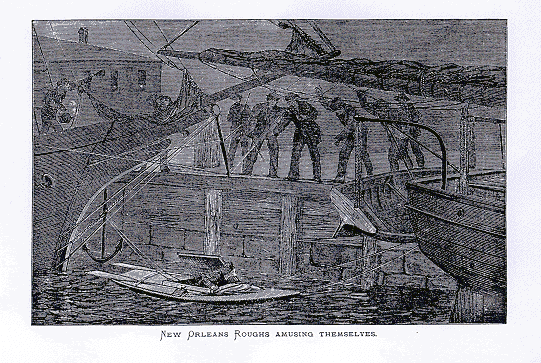
Swaggering and swearing, the roughs went ashore to refresh their thirsty throats at a low grog-shop. Having fired up, they soon returned to the bank of the canal, and, as ill luck would have it, in the darkness of the night caught a gleam of my little white boat resting so peacefully upon the foul water of the canal, made dark and heavy by the city's drainage. Then followed verbal shots, with various demonstrations, for half an hour.
The worst fellow in the crowd was a member of a fire-company, and being a city policeman was supposed to be a protector of the peace. He was very insulting; but I turned his questions and suspicions into ridicule, and, fortunately for me, he so often fell back upon the groggery for strength to fire away, that he was finally overpowered, and was given into the care of his bosom-friend, another blackguard, who dragged him tenderly from the scene. All this time the cook of the schooner had his hot water in readiness, threatening to scald the roughs if they succeeded in getting down to my boat.
At last, much to my relief, the whole party went off to 'make a night of it,' leaving me in the care of my protectors on the schooner, who had been busy deciding what they should do in case of any assault being made on me by the roughs, and showing their brawny arms in a menacing manner when the worst threats reached their ears.
I did not know this at the time, but as I looked cautiously around after the unwelcome guests had left, I saw a watchman standing on the forecastle of the Felicité, looking anxiously to the safety of the little white craft that by a slender cord held on to his vessel. All through the hours of that long night the kind-hearted master paced his deck; and then, as the sun arose, and the damp vapors settled to the earth, he hailed me with a pleasant 'good morning;' and added, 'if those devils had jumped on you last night I was to give ONE yell, and the whole fleet would have been on top o' 'em, and we would have backed every man's head down his own throat.' This wou1d have been, I thought, a singular but most effective way of settling the difficulty, and a novel mode of thinning out the city police and fire department.
During the day I was visited by a young northerner who had been for some time in New Orleans, but was very anxious to return to his home in Massachusetts. He had no money, but thought if I would allow him to accompany me as far as Florida he could ship as sailor from some port on a vessel bound for New York or Boston. Feeling sorry for the man who was homeless in a strange city, and finding he possessed some experience in salt-water navigation, I acceded to his request. Having purchased of the harbor-master, Captain M. H. Riddle, a light boat, which was sharp at both ends, and possessed the degree of sheer necessary for seaworthiness, the next thing in order was to make some important alterations in her, such as changing the thwarts, putting on half-decks, &c. As this labor would detain me in the unpleasant neighborhood, I determined to secrete my own boat from the public gaze. To accomplish this, while favored by the darkness of night, I ran it into a side canal, where the watchman of the New Lake End Protection Levee lived in a floating house. The duck-boat was drawn out of the water on to a low bank of the levee, and was then covered with reeds. So perfectly was my little craft secreted, that when a party of roughs came out to interview the 'government spy,' they actually stood beside the boat while inquiring of the watchman for its locality without discovering it.
I now slept in peace at night; but during the day, while working upon the new boat in another locality, was much annoyed by curious persons, who hovered around, hoping to discover the meaning of my movements. On Saturday evening, January 22, I completed the joining and provisioning of the new skiff, which was called, in honor of the harbor-master, the 'Riddle.' The small local population about the mouth of the canal was in a great state of excitement. The fitting out of the 'Riddle' by the supposed 'government spy' furnished much food for reflection, and new rumors were set afloat. I passed the first day of the week as quietly as possible amid the gala scenes of that section which knows no Sunday. All day long carriages rolled out from New Orleans, bringing rollicking men and women to the lake, where, free from all restraint, the daily robe of hypocrisy was thrown aside, and poor humanity appeared at its worst. Little squads of roughs came also at intervals, but their attempts to find me or my boat proved fruitless.
Source:http://www.rtpnet.org/robroy/books/nhb/S9.HTM
Illustration from the above publication--'New Orleans Roughs Amusing Themselves'.
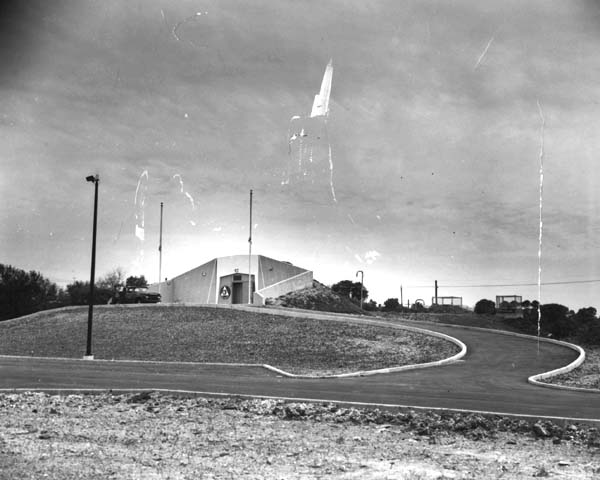
The New Basin Canal was covered during the 1950's, resulting in the Pontchartrain Expressway and West End Blvd. The Civil Defense fallout shelter was built on top of the old canal--located a few blocks from the lake. This is an exterior view, ca. 1962. Today, new houses occupy this site.
Source: http://nutrias.org/~nopl/photos/civildefense/civdef.htm
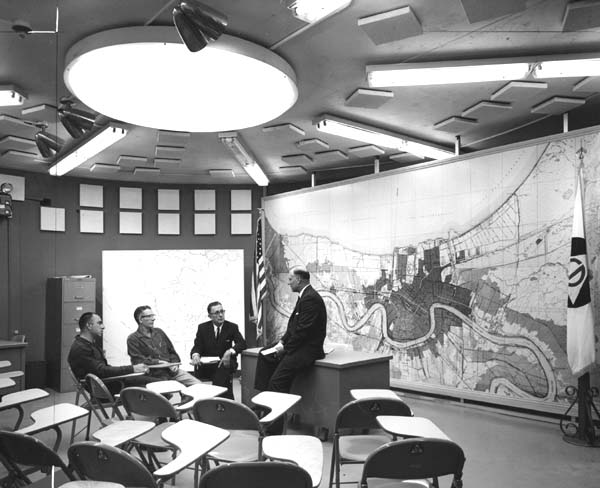
Interior view, ca. 1962. Looks like a scene from Dr. Strangelove.
Source: http://nutrias.org/~nopl/photos/civildefense/civdef.htm